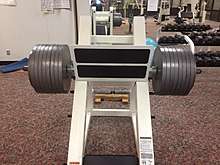Leg press
The leg press is a weight training exercise in which the individual pushes a weight or resistance away from them using their legs. The term leg press also refers to the apparatus used to perform this exercise. The leg press can be used to evaluate an athlete's overall lower body strength (from knee joint to hip). It has the potential to inflict grave injury: the knees could bend the wrong way if they are locked during a leg press.
There are two main types of leg press:
- The diagonal or vertical 'sled' type leg press. Weight disks (plates) are attached directly to the sled, which is mounted on rails. The user sits below the sled and pushes it upward with their feet. These machines normally include adjustable safety brackets that prevent the user from being trapped under the weight.
- The 'cable' type leg press, or 'seated leg press', commonly found on multigyms. The user sits upright and pushes forward with their feet onto a plate that is attached to the weight stack by means of a long steel cable.
Muscle groups
The leg press works the following muscle groups:
- Quadriceps
- Hamstring
- Gluteus maximus
- Calves (partially)
Varying the angle between the sled and the backrest and/or the position of the feet on the plate puts more emphasis on one or the other muscle group.
Magnitude of leg press lifts

As the diagonal leg press involves pushing a weight along an inclined track, rather than lifting it vertically, it is possible for strength trainers to press very heavy weight in comparison to other exercises.